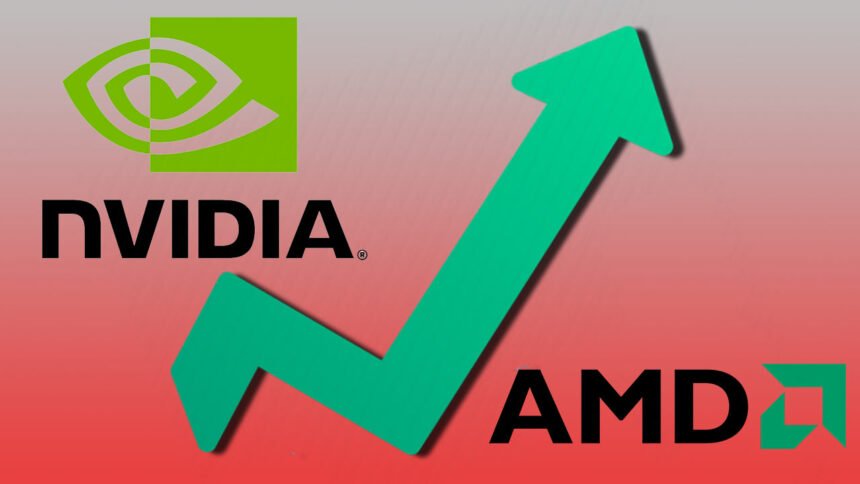AMD Stocks vs NVIDIA, The semiconductor industry is fiercely competitive, with Advanced Micro Devices (AMD) and NVIDIA standing at the forefront of innovation and investor interest. Both companies have carved significant niches in graphics processing and artificial intelligence (AI) hardware, driving substantial shareholder value. As we move through 2025 toward 2026, investors are keenly focused on how AMD stocks and NVIDIA stock price will evolve and which chipmaker will dominate the sector. This article dives deep into comparing AMD and NVIDIA, analyzing current AMD stock price trends, AMD stock forecast, after-hours trading activities, and how both companies are positioned for future growth.
Current AMD Stock Price and Market Performance
As of today, AMD stock price hovers around $237 to $250 per share, reflecting strong investor confidence given the company’s strategic advancements and market expansion. The stock demonstrates impressive growth, rising nearly 80% year-to-date in 2025, fueled primarily by AMD’s aggressive moves in AI chip development and data center expansion.
AMD’s elevated price-to-earnings (P/E) ratio of around 120 signals high growth expectations compared to past averages. The company’s earnings per share (EPS) and revenue figures consistently beat forecasts, solidifying AMD stock as a favorite among tech investors.
NVIDIA’s Strong Market Position and Stock Overview
In contrast, NVIDIA maintains a dominant position in AI-related hardware with a larger market capitalization surpassing $4 trillion. NVIDIA’s stock price, trading around $190 to $200 range in 2025, benefits from massive revenue growth driven by its proprietary CUDA software ecosystem and a near-monopoly in AI training chips.
NVIDIA’s P/E ratio, though somewhat lower than AMD’s, reflects its strong profitability and sustained high margins exceeding 40%. Year-to-date, NVIDIA’s stock has advanced approximately 35%, a testament to its leadership in the AI and gaming chip markets.
AMD vs NVIDIA: Market Share and Growth Prospects
Market Share Dynamics
NVIDIA currently holds approximately 90% of the AI training hardware market, thanks to its established CUDA ecosystem and deep enterprise relationships. Meanwhile, AMD is gaining ground, projecting AI chip sales of $7.6 billion by 2025, emphasizing its growing presence with competitive GPUs like the MI300X series.
In gaming CPUs and GPUs, AMD has made significant gains with its Ryzen processors and Radeon graphics cards, capturing increasing market share from Intel and NVIDIA by offering high performance at competitive prices.
Growth Drivers for AMD Stocks
-
Strategic AI partnerships, including a key deal with OpenAI.
-
Expansion in cloud and data center markets with EPYC server CPUs.
-
Acquisition of AI hardware and software companies to accelerate innovation.
-
Aggressive pricing and product innovation in gaming GPUs.
NVIDIA’s Growth Catalysts
-
Deep integration of CUDA in AI development, offering a strong competitive moat.
-
Expanding footprint in autonomous vehicles, AI inference, and data centers.
-
High-margin businesses with rapid revenue growth exceeding 50% year-over-year.
-
Frequent product launches aligned with emerging AI workloads.
AMD Stock Forecast vs NVIDIA: Analyst Predictions for 2026
Analysts remain bullish on both AMD and NVIDIA but highlight important differences:
| Metric | AMD Stock Forecast | NVIDIA Stock Forecast |
|---|---|---|
| 2026 Price Target Range | $275 to $350 | $210 to $250 |
| Expected Growth Rate | 25%-40% year-over-year | 20%-30% year-over-year |
| Key Risks | High valuation, competition pressure | Market saturation, high valuation |
| Analyst Ratings | Majority “Buy” with some “Hold” | Majority “Strong Buy” |
AMD’s forecast benefits from accelerated AI adoption and expanding data center revenue, while NVIDIA’s predictions lean on its entrenched market dominance and technology leadership.
After Hours Trading Insights: AMD Stock Movements
AMD after hours trading reflects rapid market reactions to earnings releases, partnership announcements, and AI developments. Prices in after-hours sessions typically range between $237 and $250, mirroring strong investor interest and providing clues to the next trading day’s opening price.
Investors looking at AMD stock price today and beyond should consider after-hours data alongside traditional trading hours to get a full picture of investor sentiment.
Which Chipmaker Will Dominate in 2026?
AMD Stocks vs NVIDIA, While NVIDIA currently leads with dominant market share and profitability, AMD’s rapid growth, competitive pricing, and strategic AI partnerships make it a formidable challenger. The race between AMD stocks and NVIDIA is expected to accelerate in 2026, with key battlegrounds being AI hardware adoption, gaming performance, and data center expansion.
Investors seeking growth might find AMD compelling given its higher growth rate and value proposition. Conversely, those prioritizing market leadership and a broad AI ecosystem might lean toward NVIDIA.
Read More: AMD Stock Price Analysis: Key Factors Driving the Current Rally
Conclusion
AMD stocks and NVIDIA stock price trends highlight a dynamic semiconductor market shaped by AI innovation and evolving computing demands. Both companies offer significant growth prospects, though through different strategies and market positions. Tracking AMD stock price today, after hours trading insights, and understanding analyst forecasts will be critical for investors navigating this competitive landscape.









